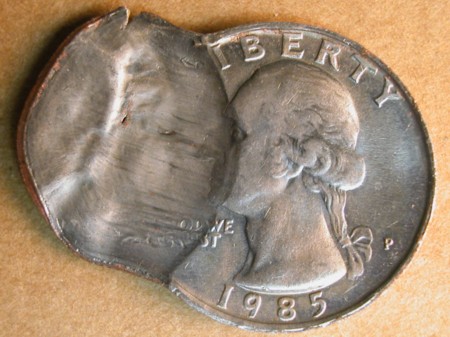Part VI. Striking Errors:
Multiple Strikes:
Delayed Second Strike
Definition: A delayed second strike is one that is delivered in a different striking chamber or coinage press after a considerable delay. Coins carrying strikes with two different dates are an obvious example. In the absence of such an obvious clue, collectors must probe a little deeper.
A delayed second strike will be delivered in a different striking chamber and will therefore carry different die markers. Die markers are blemishes — often microscopic — that serve to identify a particular die pair. Die cracks, die scratches, die dents, and die flow lines are just some of the markers to inspect.
Not all coins struck by a different die pair represent a delayed second strike. Lower denominations (cents, nickels, and dimes) were often struck in dual or quad presses in which die pairs were arranged in adjacent couplets. A newly-struck coin could easily move from one member of the couplet to another.
For higher denominations, a strike from a different die pair would represent a delayed second strike as the dies were never arranged in adjacent couplets.
A delayed second strike can also be identified by the presence of inter-strike damage of a kind that could not be generated within a striking chamber.
Shown below is a 1985-P quarter with a delayed second strike. After a normal first strike, the reeding was completely shaved off the edge and the coin was rolled and squeezed to a smaller diameter. It was then transported to a distant striking chamber (and probably different press) where it received a flipover, off-center, uniface strike. The die pair that delivered this second strike was characterized by an unstable hammer (obverse) die or die assembly that was swinging from side to side. This produced an extreme case of collar clash on the left side (the first strike shows no signs of collar clash in the corresponding area. A swing to the right followed after the hammer die reached the lowest point of its downstroke. This produced a dramatic case of slide doubling (a form of machine doubling).



